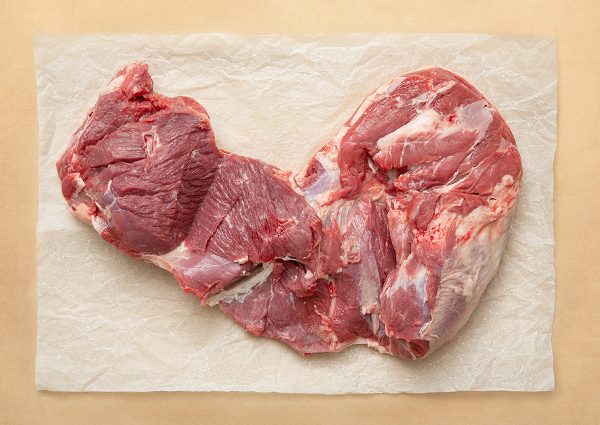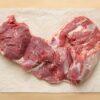Need to buy lamb leg? Then our lamb leg will be your best friend. Our lamb leg is directly from our farm. They are healthy, rich in iron and many other nutrients.
Lamb Nutritional Value
The nutritional value of lamb is impressive; it contains a range of beneficial nutrients including protein, healthy fats, vitamins and minerals.
The tables below show the full range of nutrients in cooked domestic lamb (leg shank) per 100 grams .
Calories and Macronutrients
| Macronutrient / Calories | Amount (Grams / Kcal) |
| Calories | 243 kcal |
| Carbohydrate | 0 g |
| Fiber | 0 g |
| Sugar | 0 g |
| Fat | 13.5 g |
| Saturated Fat | 5.6 g |
| Monounsaturated Fat | 5.7 g |
| Polyunsaturated Fat | 1.0 g |
| Omega-3 | 190 mg |
| Omega-6 | 730 mg |
| Protein | 28.4 g |
As shown above, lamb is a mixture of fat and protein.
Health Benefits Of Lambchop
Aside from the nutrient profile, lamb has many other nutritional benefits.
Here are some good reasons to eat lamb.
1. Lamb Contains L-Carnosine
L-Carnosine is a compound that contains two amino acids (proteins) bonded together; beta-alanine and histidine.
Only certain foods contain carnosine in high amounts, and lamb is one of these.
Per 100 grams, lamb contains – on average – 400mg of carnosine, which is slightly higher than beef (365mg).
L-Carnosine’s Health Benefits
Firstly, carnosine is classed as a non-essential nutrient because our bodies can make it internally.
However, recent research is showing that higher amounts of carnosine from external sources may offer additional health benefits.
Among these, carnosine appears to have anti-atherosclerotic effects, meaning that it may help to protect against cardiovascular disease.
Notably, carnosine also helps to reduce the glycation of sugars and proteins in our body.
Glycation leads to the formation of advanced glycation end products (AGEs).
Unfortunately, AGES are harmful compounds which directly cause inflammation and oxidative stress, and they are believed to be one of the keys to the aging process.
2. Lamb is a Significant Source of Complete Protein
One of the biggest positives from eating lamb is the protein content.
Lamb is extremely rich in protein, and depending on the cut it contains anywhere between 25 – 30 grams per 100 grams.
While it is common knowledge that lamb is an excellent source of protein, not all protein is made the same.
In other words; the efficiency by which our body can use protein differs depending on the specific food and the amino acids it contains.
On the positive side, lamb contains every amino acid, and we can, therefore, class it as a ‘complete’ protein.
This completeness means that our body can use lamb protein more efficiently than ‘incomplete’ proteins in plant foods.
Protein is incredibly important for our health, and it encourages lean muscle mass, the growth and repair of cells, and higher levels of satiety.
3. Lamb Is Incredibly Nutrient Dense
While some people like to judge food based on how many calories it contains, the caloric load says little about the food’s relative health merits.
The best measurement of the health properties of a particular food is nutrient density.
Lamb passes the nutrient-density test with flying colors, and here is a quick summary of why;
- Lamb contains large amounts of healthy fat, including more omega-3 than most land animals and high levels of oleic acid.
- High concentrations of bio-available, highly digestible protein.
- A substantial amount of vitamins and minerals; particularly B vitamins and zinc.
- A range of beneficial compounds including creatine, glutathione, conjugated linoleic acid, carnosine and taurine.
4. A Surprising Source of Omega-3 Fatty Acids
In the modern world, most people are consuming too much omega-6 and not enough omega-3. This issue is important because omega-3 fatty acids have an anti-inflammatory effect, while omega-6 is pro-inflammatory.
Providing these two essential fatty acids are relatively balanced, they are both useful and beneficial. However, some people are now eating a diet that is approaching 20:1 in favor of omega-6 to omega-3.
Removing omega-6 vegetable oils such as soybean oil is a great way to change this. Additionally, consuming omega-3 fatty acids from seafood (especially oily fish) helps us to get more omega-3.
However, land animals can also be rich in omega-3.
This is especially the case for animals raised on pasture. As one such animal, lamb tends to be an excellent source of omega-3.
In pasture-raised lamb, the levels of omega-3 are higher than grain-finished animals.
As an example, 100 grams of grass-fed lamb rib contains 580 mg of omega-3 and 750 mg of omega-6; nearly a 1:1 ratio.
5. An Important Source of Heme Iron
Many different foods contain iron and it is present in everything from spinach and kale to bananas and tomatoes.
However, just as the digestibility of protein differs, not all iron is made the same.
When it comes to digestion and absorption, heme iron is king.
In fact, we can absorb approximately 15-35% of heme iron (found in animal foods), but this absorption rate drops to 10-15% for non-heme sources of iron (plant foods) .
It is unfortunate to see the rise of iron-deficiency anemia.
Over the period between 2004 and 2013, iron-deficiency anemia rates in the US population nearly doubled to 5.6%. During the same decade, red meat consumption fell by 19%.
Importantly, lamb contains a rich source of heme iron in amounts similar to other red meat such as beef.
6. Lamb Contains a Significant Amount of Creatine
Creatine will be well known to anyone with interest in working out and/or sporting performance.
Markedly, creatine can help to boost muscular endurance, strength and – potentially – muscle mass.
While creatine supplements are very popular, this compound also occurs naturally in various foods.
Red meat is the most substantial dietary source of creatine and lamb contains approximately 300-500 mg per 100 grams.
Although this is not close to the same level as creatine supplement dosages (3 – 5 grams per day), it should still have a physiological benefit – especially for those eating higher amounts of lamb and beef.
7. Lamb is a Source of the “Master Antioxidant” Glutathione
People often refer to glutathione as “the master antioxidant” because of the critical role it plays in protecting our health and our internal antioxidant defense systems .
We cannot read too much into this since there is no clinical research on humans, but higher glutathione levels track with a longer lifespan in animal studies.
Notably, our body makes the glutathione compound internally from the amino acids cysteine, glutamic acid and glycine.
However, research suggests that consuming more exogenously (from outside sources; i.e. food) could have advantages.
On this note, a further health benefit of lamb is that it contains glutathione.
Also, it contains all three amino acids that our body requires to synthesize glutathione internally.
Nationwide Delivery
Organic foods offers nationwide delivery of lamb leg at an affordable price.
100% Organic
Quality Guaranteed
Non-Adulterated Products
100% Healthy
100% Affordable
Organic foods offers nationwide delivery of lamb leg at an affordable price. Order now!
We deliver within 24 hours. Same day delivery also available (conditions applies)





Reviews
There are no reviews yet.